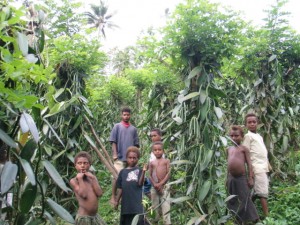Covanee Journey – Intro
Covanee Journey – Intro
Our journey started with a phone call from a friend in 2002. Sam Heidema, a dear friend of ours since our days as missionaries in Papua New Guinea (PNG), called us with information provided to him by his parents who were still working in PNG as missionaries at that time. The information he imparted to us was that vanilla beans, a previously unknown cash crop in PNG, was spreading like wildfire throughout the country.
In 2000, devastating series of cyclones in the Madagascar destroyed a third of all pod producing vanilla plants in the country, crippling the world’s top producer with 60% of the market share. The shortage in turn dove up the wholesale price from $50 per kilogram to over $500 per kilogram1. The ensuing profitability caused many countries previously with zero experience with vanilla such as PNG to jump on board the bandwagon.
In PNG, vanilla was first brought over through the western border of Sepik Province from Indonesia, a vanilla producing country before the price hike. From the Sepik Province, vanilla beans spread to its neighboring province, Madang and from there to every corner of the country, even to the outlying island provinces.
At this time, legends were born. A gentleman from the Sepik boarded a plane with his son with all of their baggage, even their carry-ons filled with cured vanilla beans and flew into LAX and sold his vanilla beans at $400 per kilogram. Even with the customs fiasco he had to get through and the surcharges he had to pay for the excess weight, and the two week stay in LA, the father and son duo came back with enough cash to buy a four-wheel-drive truck, roofing for his new house, a solar panel system and more. More commonly, buyers from overseas came into Wewak, and bought beans regardless of length or quality. The buyers were even buying green beans still on the vine for cash.
The wanton rampage that consumed the vanilla industry did not last long however. After four years, the vines that were destroyed by the cyclones post 2000 were replanted and producing beans once again in Madagascar. By 2005, the vanilla market could feel a crash in vanilla price in the making. With Madagascar again producing 60% of the world production, the excess production that was created to fill the void in 2000 by other countries overflowed the market in 2005. By 2006, the price for wholesale vanilla beans dropped to around $15. The people in PNG who had high hopes just the year before were devastated, and in some cases resorted to cutting and burning there vanilla fields in anger. During this time of extreme volatile prices, some growers inserted 6 inch nails into their beans in attempt to increase weight. This caused certain prominent buyers from overseas to withdraw from PNG and focus back more on established vanilla growing countries such as Madagascar, Uganda, and Indonesia, furthering PNG’s woes.
It was at this time we heard and responded to the distress call coming from Kupdui village and the people we worked with from 1986 to 2002. In an attempt to give consistency and structure to the growers that we have come to know personally and love, we headed to PNG for the first time as non-missionaries in last month of 2006.
And here our story truly begins.
Cocoa, Vanilla and Coffee
Covan’ee…

